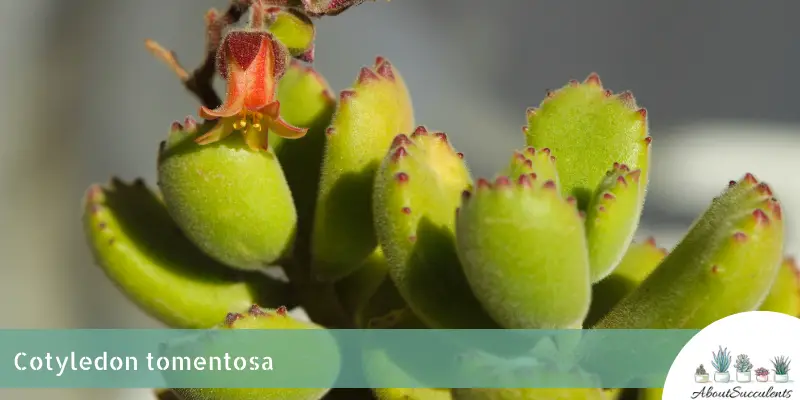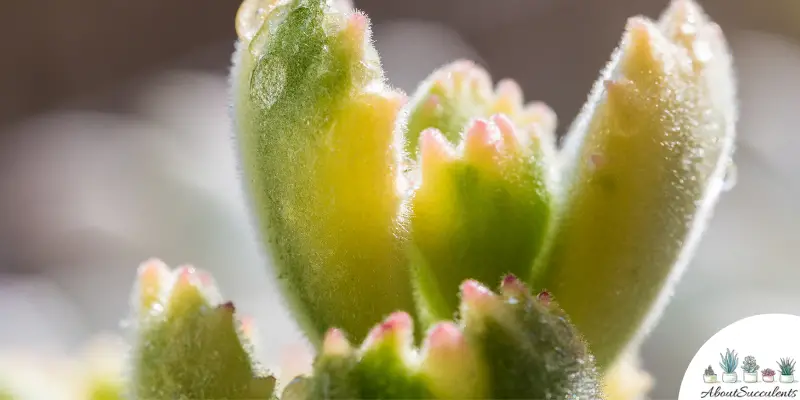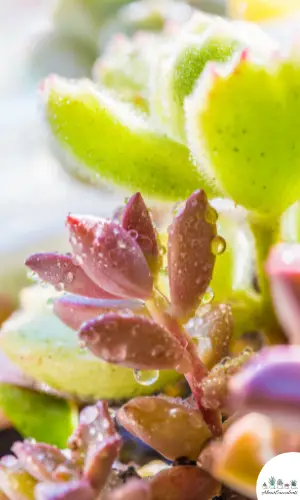
Cotyledon tomentosa is a captivating addition to anyone’s succulent collection. Its oddly enchanting thick green leaves with the fuzzy exterior and dark red spindly edges are why this succulent is also called Bear’s Paw.
When stressed out or given regular sun exposure, the tips of the leaf turns into a darker shade of red. Each leaf has around 3 to 10 sharp edges or “claws”.
Unlike its burly namesake, Bear’s Paw is a small, succulent-shrub that can reach a height of 30cm (12”) and 61cm (24”) wide.
Cotyledon tomentosa is native to Ladismith in the Karoo region of the Western Cape of South Africa. It’s a member of the Crassulaceae family and bears cup-shaped, orange-red flowers from winter to spring.
General Information:
Also known as: Bear’s Paw
Plant Family: Crassulaceae
Origin: Western Cape of South Africa
Height: 30cm (12”)
Exposure: Partial or indirect morning sun for 6 hours
Water Needs: Soak and dry method; water the soil when it’s 100 dry then give it a thorough soaking.
Soil Type: Cactus mix with sand and perlite to improve drainage.
Soil pH: 6.0
How to Grow and Care for Cotyledon Tomentosa

Cotyledon tomentosa is an ideal succulent plant for first-time hobbyists because it’s very easy to grow and care for. You can grow Bear’s Paw as a garden succulent or as an indoor plant.
Keep in mind that this type of succulent is not cold-hardy. If your region’s temperature can fall below -1° C (30° F), it would be recommended to house Cotyledon tomentosa in a pot that can be moved indoors.
Sunlight
Bear’s Paw needs plenty of sunlight to grow properly. As part of your outdoor garden landscape, place Cotyledon tomentosa in a location that gets 6 hours of partial or indirect morning sunlight every day.
If you prefer Bear’s Paw as a houseplant, the best location would be near a window that receives 6 hours of partial sunlight every day.
Watering
Cotyledon tomentosa has the same watering requirements as other varieties of succulent plants. This means that you only give it water when the soil has completely dried out.
Giving Bear’s Paw water while its soil still has moisture will increase the risk of root rot. When the roots start to rot, fungal infection can set in immediately and affect the health of the plant.
The best approach for watering is the soak and dry method. First, insert a stick into the topsoil. If the end of the stick feels dry after you pull it out, give the soil a thorough watering until it’s completely soaked.
Do not water again until the soil is stone dry. Succulents such as Bear’s Paw are drought-tolerant and can survive without water for a long time.
Cotyledon tomentosa will require more water during the summer and less in the wintertime when the soil tends to hold moisture longer.
Pot and Soil

This succulent plant will love you for housing it inside a pot made of ceramic or terracotta. The advantage of these types of pots over plastic or glass is that they allow moisture to escape along its sides.
Another important thing to consider when choosing a pot for Bear’s Paw is that it should have a drain hole with a mesh cover at the bottom to allow water to fall through without losing soil.
Cotyledon tomentosa grows best in well-draining soil such as cactus mix. You can add ingredients such as perlite and sand to further improve draining and prevent root rot from taking place.
How to Propagate Cotyledon Tomentosa
If your Cotyledon tomentosa has made your outdoor garden the talk of the succulent growers club and you want more, you can easily propagate this succulent plant.
There are 3 methods of propagation to choose from: Seeds, Leaf Cuttings, and Stem Cuttings.
Method 1: Seeds
Step 1: Sow Bear’s Paw seeds in well-draining soil such as standard potting or cactus mix.
Step 2: Lightly moisten the soil with water and place it near a place that gets partial sunlight then cover it with plastic to initiate germination.
Step 3: In a few weeks, you might see seedlings sprouting out. Remove the plastic cover and water the soil only when it’s completely dry.
Method 2: Stem Cuttings
Step 1: Select a healthy stem from the main plant.
Step 2: With a sterilized and sharpened pair of garden shears, cut the stem cleanly off the main plant.
Step 3: Leave the stem cuttings in a warm place and allow them to develop hard calluses.
Step 4: After 2 to 3 days, place the hardened stem cuttings on top of well-draining soil.
Step 5: Lightly mist the soil when it has dried out.
Method 3: Stem Cuttings
Step 1: Remove a healthy leaf from the stem by performing a clean twist and pull. Make sure there’s no part of the leaf on the stem to assure you of successful propagation. You can also cut the leaf off with a sharpened and sterilized knife or garden shears.
Step 2: Allow the leaf cuttings to callus over a period of 2 to 3 days.
Step 3: Place the leaf cuttings on a pot filled with a fresh cactus mix.
Step 4: Water the soil only if it’s 100% dry.
Frequently Asked Questions
Is Cotyledon Tomentosa Toxic to Cats and Dogs?
Cotyledon tomentosa is not listed on the website of the American Society for the Prevention of Cruelty to Animals (ASPCA) as a plant that’s toxic to animals.
Keep in mind that the list is incomplete and there are reports that Bear’s Paw can be mildly toxic to pets.
As much as possible, keep your pets far from this succulent plant. If you suspect that your pet might have ingested Bear’s Paw, bring the animal to the veterinarian right away.
Why Is My Cotyledon Tomentosa Dying?
Bear’s Paw’s eye-catching leaves are very sensitive to fungal infection. If you notice discoloration on the leaves, your beloved succulent might have rotting roots from overwatering or acquired diseases from pests.
Overwatering
Water is a source of life but giving Cotyledon tomentosa too much of it will lead to the succulent’s death.
Succulents thrive with less water and Bear’s Paw is no exception. Don’t give water until you can test the moisture level of the soil. The rule is simple: Just make sure the soil is absolutely dry before giving it water.
If you see discoloration on the leaves or any part of the plant, cut it off right away with a sanitized pair of garden shears. Remove the plant from the soil and cut off the rotten roots.
While Bear’s Paw is drying off, prepare a new pot with fresh cactus mix and replant the rejuvenated succulent.
Pest Infestation
Cotyledon tomentosa’s leaves attract mealybugs, aphids, and spider mites. The most aggressive pest is the cochineal. These insects will weaken your succulent by drinking away the sap from the leaves.
If you see white, cotton-like substances on the leaves of Bear’s Paw, your succulent is harboring insects that pose serious threats to its health.
Wipe off the white substances from the leaves with 70% isopropyl alcohol or spray the succulent plant with neem oil to keep the pests away.
Does Cotyledon Tomentosa Produce Flowers?
Yes, Cotyledon tomentosa blooms cup-shaped, orange-red flowers that last from winter to spring.
Last Updated on June 9, 2022 by Sofia Lara